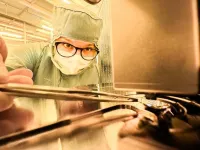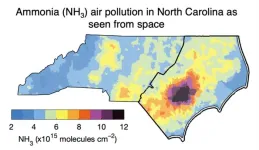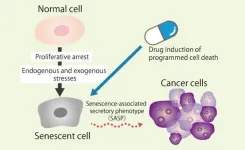(Press-News.org) As humankind imagines living off-planet — on the moon, Mars and beyond — the question of how to sustain life revolves around the physical necessities of oxygen, food and water. We know there is water on the moon, but how do we find it? Is it in the craters? The shadowed regions? The poles? Knowing where to look gives astronauts the best chance at successfully living on the moon, something that has, heretofore, remained the stuff of science fiction.
Researchers from the University of California San Diego may help bring science fiction to reality by providing a divining rod to guide future space missions, including NASA’s Artemis campaign, which seeks to explore and, eventually, inhabit the moon. Their work appears in a special issue of Proceedings of the National Academy of Sciences (PNAS) called “Water on the Moon and Mars,” which features Artemis I on its cover.
The researchers included the father-son team of Mark Thiemens, UC San Diego Distinguished Professor of Chemistry and Biochemistry, and Maxwell Thiemens, a research fellow at the Vrije Universiteit Brussel, who is also an alumnus of Scripps Institution of Oceanography.
In 1967, Nobel laureate Harold Urey and James Arnold — both faculty members in UC San Diego’s Department of Chemistry — were among the first to receive Apollo 11 lunar samples. Urey was one of the first scientists to theorize that there was water on the moon, particularly in the permanently shadowed regions of the moon’s poles. Today, scientists believe that water on the moon originated from one of three sources:
indigenous to the moon,
created by solar winds (where hydrogen from the sun reacts with oxygen at high energy on the moon and likely Mars to create water)
deposition (from icy comets that have crashed onto the lunar surface).
On Earth, human civilizations often bubble up near bodies of water and it would be no different in space. On the moon, it’s important to know the origin of the water sources because it will give astronauts guidance on where it would be most prudent to set up bases and habitats.
To learn about the origin of water on the moon, Morgan Nunn Martinez (who was a UC San Diego graduate student at the time) extracted very small amounts from lunar rocks collected from the 1969 Apollo 9 mission. It may sound implausible to get water from a rock, but it is possible through “thermal release,” a process where lunar samples were heated to 50, 150 and 1,000 degrees Celsius (122, 302, and 1,832 degrees Fahrenheit respectively). As it turns out, these rocks were surprisingly “wet.”
The lowest temperatures released lightly bound water molecules — those molecules that are attached to other molecules (in this case, lunar rock) through a weak attraction. At 1,000 degrees Celsius, tightly bound water molecules, which are more deeply embedded in the rock, were released.
Through this process, gas water molecules are collected, then purified so that only the oxygen remains. The team then measured the composition of three different oxygen isotopes.
Isotopes are atoms of the same element that have varying numbers of neutrons, which changes their mass — the more neutrons, the heavier the atom. These measurements are particularly useful in determining a substance’s origin and age.
Think of it like space forensics. In the way humans have unique fingerprints, astronomical objects, like comets and the sun, have unique signatures. Scientists are able to look at the oxygen isotope measurements and determine the origin of the water.
Their data revealed that most of the lunar water likely originated from the moon itself or from comet impacts. Contrary to popular belief, solar winds did not significantly contribute to the moon’s water stores.
“What’s nice about this research is that we’re using the most advanced scientific measurements and it supports common sense ideas about lunar water — much of it has been there since the beginning and more was added by these icy comet impacts,” stated Maxwell Thiemens. “The more complicated method of solar wind-derived water doesn’t appear to have been that productive.”
Although not a main thrust of the paper, the researchers also measured samples from Mars. If NASA’s Artemis program is able to successfully colonize humans on the moon, it would bode well for the ultimate mission of inhabiting Mars.
“This kind of work hasn’t been done before and we think it can provide NASA with some valuable clues about where water is located on the moon,” stated Mark Thiemens. “The real goal of Artemis is to get to Mars. Our research shows that likely there is at least as much water on Mars as on the moon, if not more.”
Of course, locating the water is only the first step. Being able to extract it from lunar rocks and soil in quantities large enough to sustain life will require further technological advancements and discovery.
Full list of authors: Maxwell Thiemens (Vrije Universiteit Brussel), Morgan Nunn Martinez and Mark Thiemens (UC San Diego).
This research was supported, in part, by a NASA Earth and Space Science Fellowship, a Zonta International Amelia Earhart Fellowship and the Achievement Rewards for College Scientists Fellowship.
END
Follow the water: Searching for a lunar oasis
New research may help astronauts locate viable water sources on the moon
2025-01-28
ELSE PRESS RELEASES FROM THIS DATE:
Ocean-surface warming four times faster now than late-1980s
2025-01-28
The rate of ocean warming has more than quadrupled over the past four decades, a new study has shown.
Ocean temperatures were rising at about 0.06 degrees Celsius per decade in the late 1980s, but are now increasing at 0.27 degrees Celsius per decade.
Published today (Tuesday, 28 January 2025) in Environmental Research Letters, the study helps explain why 2023 and early 2024 saw unprecedented ocean temperatures.
Professor Chris Merchant, lead author at the University of Reading, said: “If the oceans were a bathtub of water, then in the 1980s, the hot tap was running slowly, warming up ...
Study explores whether dietary supplement could provide first effective treatment for cirrhosis
2025-01-28
A dietary supplement used to build muscle – or prevent muscle loss as a result of ageing or illness – is to be trialled as a potential treatment for chronic liver disease.
Β-hydroxy β-methylbutyrate, otherwise known as HMB, is used predominantly to build muscle bulk and function but previous studies have demonstrated it can have clinical applications.
In a new study, scientists and clinicians will test its potential to benefit some of the 60,000 people in the UK who have been diagnosed with cirrhosis, a condition that results from scarring to the liver.
In the UK, cirrhosis is most commonly caused by harmful alcohol use or fatty liver disease. In severe cases, those ...
Individual cells can be connected to plastic electrodes
2025-01-28
Researchers at Linköping University have succeeded in creating a close connection between individual cells and organic electronics. The study, published in Science Advances, lays the foundation for future treatment of neurological and other diseases with very high precision.
“We could target individual cells and explore how this affected their ability to stay healthy and functional,” says Chiara Musumeci, researcher at the Laboratory of Organic Electronics, LOE, at Linköping University.
The brain is controlled by electrical signals that are converted into chemical substances in the communication between the brain ...
University of Virginia study reveals air pollution inequities linked to industrial swine facilities are detectable from space
2025-01-28
A groundbreaking study led by researchers from the University of Virginia has used satellite measurements to show the long-term persistence of air pollution inequalities tied to industrialized swine facilities in Eastern North Carolina. Using satellite data spanning a 15-year period from 2008–2023, the study quantifies disparities in ammonia (NH₃) — an air pollutant emitted by swine operations — for Black, Hispanic and Indigenous communities. These inequalities, exacerbated by hot and calm weather ...
Cell death and aging in cancer research review
2025-01-28
Aging cells secrete substances known to promote the growth of cancer cells. The development of drugs that can selectively kill these cells or inhibit the secretion of substances is ongoing. The latest findings on the interaction between cell death and cellular senescence in cancer and their pathophysiological significance have been reviewed by a team from Osaka Metropolitan University’s Graduate School of Medicine and Harvard Medical School.
Lecturer Kouhei Shimizu and Professor Fuminori Tokunaga of OMU and Dr. Hiroyuki Inuzuka of Harvard Medical School outlined ...
Flame retardants in battery enclosures may do more harm than good
2025-01-28
As dangerous lithium-ion battery fires are on the rise, regulators and manufacturers are scrambling for solutions. Unfortunately, one common strategy may cause serious health harm and not work to slow or stop the fires. A new Viewpoint in Environmental Science & Technology explains that adding flame retardants to the plastic cases surrounding these batteries has no proven fire-safety benefit. The scientists further warn that the types of flame retardants widely used in electronics enclosures are linked to cancer and other health harms and can end up in children’s toys, food containers, and other products made from recycled plastic.
“The use of flame ...
Kenya study highlights complexity of tree-planting schemes
2025-01-28
Research with smallholder farmers in Kenya shows that tree-planting schemes must account for complex local issues and preferences.
Tree planting is central to many countries’ climate mitigation and biodiversity conservation goals, and Kenya alone plans to plant 15 billion trees by 2032.
Adding trees and shrubs to farmland (called agroforestry) can boost biodiversity, carbon storage, soil health, food production and income. But many tree-planting schemes overlook diversity and promote a narrow range of species.
The new study – led by the University of Exeter – examined the factors that enable or prevent Kenyan smallholders from increasing the diversity of ...
Transforming longevity research: AI paves the way for personalised treatments in ageing science
2025-01-28
A collaborative study between researchers from the Yong Loo Lin School of Medicine, National University of Singapore (NUS Medicine), and the Institute for Biostatistics and Informatics in Medicine and Ageing Research, Rostock University Medical Center, Germany, investigated how advanced AI tools, like Large Language Models (LLMs), can make it easier to evaluate interventions for ageing and provide personalised recommendations. The findings were published in the leading review journal Ageing Research Reviews.
Research into ...
Humanoid robots join human musicians for synchronized musical performances
2025-01-28
In a fascinating blend of technology and artistry, researchers present a study in PeerJ Computer Science, showcasing how humanoid robots can collaborate seamlessly with human musicians during live musical performances. This innovative work highlights the evolving role of robotics in entertainment and creativity.
The study introduces a human-robot musical band featuring Polaris, a mid-sized humanoid robot as a drummer, and Oscar, a Robotis-OP3 humanoid robot as a keyboardist. These robots performed alongside human musicians, achieving natural synchronization and ...
Regularly seeing the same GP could free up NHS appointments, research shows
2025-01-28
New research indicates that regularly seeing the same GP could reduce workload in practices and hospitals, potentially freeing up appointments for patients.
The study was conducted by Cambridge Judge Business School, University of Cambridge, the University of Exeter Medical School and St Leonard’s Practice in Exeter. The research focuses on continuity of care – whether there’s any benefit from patients seeing the same GP at most of their appointments. This continuity has been steadily decreasing in patient care since 2012, and increasingly patients see multiple GPs within a practice, or temporarily placed GPs, known as locums.
Now, the new research, published in the ...
LAST 30 PRESS RELEASES:
Scientists use ultrasound to soften and treat cancer tumors without damaging healthy tissue
Community swimming program for Black youth boosts skills, sense of belonging, study finds
Specific depressive symptoms in midlife linked to increased dementia risk
An ‘illuminating’ design sheds light on cholesterol
Who is more likely to get long COVID?
Study showcases resilience and rapid growth of “living rocks”
Naval Research Lab diver earns Office of Naval Research 2025 Sailor of the Year
New Mayo-led study establishes practical definition for rapidly progressive dementia
Fossil fuel industry’s “climate false solutions” reinforce its power and aggravate environmental injustice
Researchers reveal bias in a widely used measure of algorithm performance
Alcohol causes cancer. A study from IOCB Prague confirms damage to DNA and shows how cells defend against it
Hidden viruses in wastewater treatment may shape public health risks, study finds
Unlock the power of nature: how biomass can transform climate mitigation
Biochar reshapes hidden soil microbes that capture carbon dioxide in farmland
Reducing saturated fat intake shows mortality benefit, but only in high-risk individuals
Manta rays create mobile ecosystems, study finds
Study: Mixed results in using lipoic acid to treat progressive multiple sclerosis
Norbert Holtkamp appointed director of Fermi National Accelerator Laboratory
New agentic AI platform accelerates advanced optics design
Biologists discover neurons use physical signals — not electricity — to stabilize communication
Researchers discover that a hormone can access the brain by hitchhiking
University of Oklahoma researcher awarded funding to pursue AI-powered material design
Exploring how the visual system recovers following injury
Support for parents with infants at pediatric check-ups leads to better reading and math skills in elementary school
Kids’ behavioral health is a growing share of family health costs
Day & night: Cancer disrupts the brain’s natural rhythm
COVID-19 vaccination significantly reduces risk to pregnant women and baby
The role of vaccination in maternal and perinatal outcomes associated with COVID-19 in pregnancy
Mayo Clinic smartwatch system helps parents shorten and defuse children's severe tantrums early
Behavioral health spending spikes to 40% of all children’s health expenditures, nearly doubling in a decade
[Press-News.org] Follow the water: Searching for a lunar oasisNew research may help astronauts locate viable water sources on the moon



